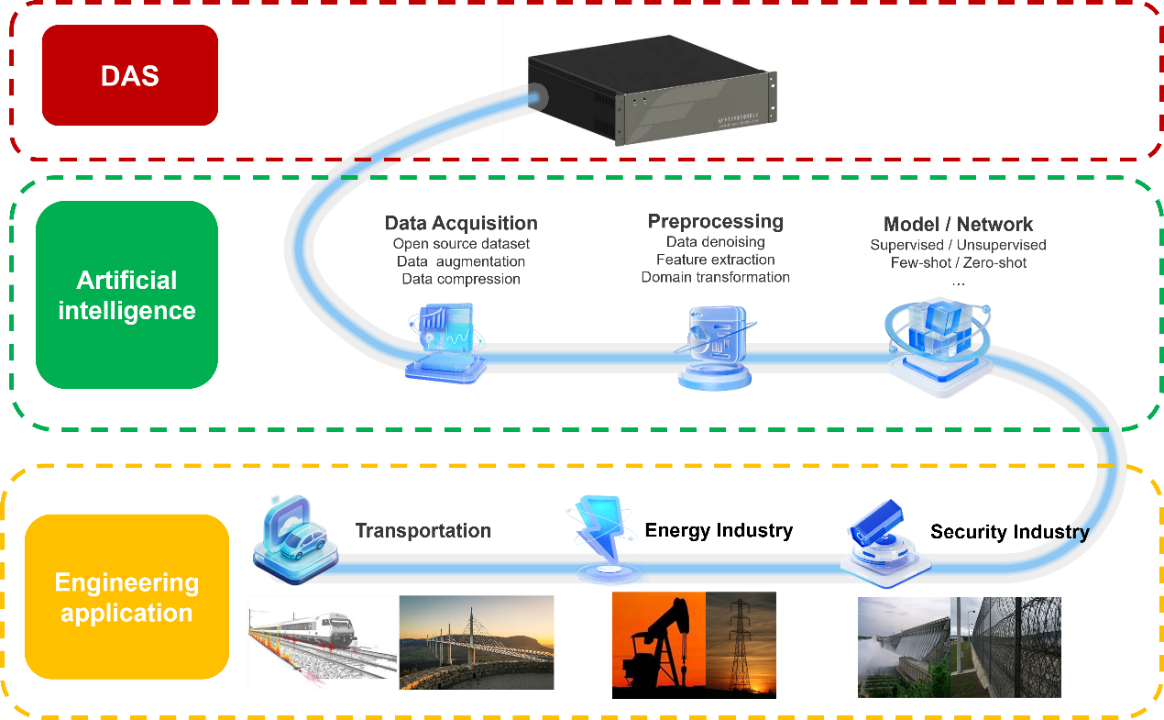As national infrastructure systems expand in scale and complexity, the demand for more intelligent, real-time monitoring solutions has surged. Artificial intelligence-driven distributed acoustic sensing (AI+DAS) technology offers a powerful solution by enabling real-time monitoring, risk detection, and predictive maintenance across large-scale engineering applications.

Professor Liyang Shao’s team from the Department of Electronic and Electrical Engineering at the Southern University of Science and Technology (SUSTech), in collaboration with PipeChina Institute of Science and Technology, Shenzhen Gas Corporation Ltd., Hong Kong Polytechnic University, and the Research Institute of Tsinghua University in Shenzhen (RITS), has published an invited review paper that explores the current progress and future prospects of this technology.
From the perspective of major engineering applications and interdisciplinary integration, their review systematically discusses the application advantages and development potential of AI+DAS technology in key areas such as infrastructure health monitoring, oil and gas pipeline safety early warning, intelligent perimeter protection, and earthquake monitoring and early warning.
Their paper, titled “Artificial intelligence-driven distributed acoustic sensing technology and engineering application”, has been published in the international academic journal PhotoniX.
The team reviewed key technological principles such as Φ-OTDR to analyze the unique value of fiber optic sensing in long-distance, high-resolution, and large dynamic range monitoring. They also explored how to enhance system intelligence and adaptability in stages like data acquisition, noise reduction, feature extraction, and pattern recognition from the perspective of artificial intelligence algorithms.
Starting from application scenarios and demands in three major engineering fields—transportation, energy, and safety—they demonstrated the significant effects of AI in real-time data analysis and risk identification, while also discussing ongoing challenges such as the lack of high-quality data sets, high algorithm complexity, and the difficulty of integrating multiple scenarios. Through exploration of technological trends and interdisciplinary integration, readers can gain a more comprehensive understanding of the current development status and future direction of AI+DAS technology, providing valuable references for advancing relevant research and practices in more industries and application scenarios.

Figure 1. Artificial intelligence-driven distributed acoustic sensing technology and engineering application
Regarding the future development of this field, researchers will leverage unsupervised and semi-supervised learning technologies to reduce reliance on high-quality annotated data, while actively exploring lightweight models to address algorithm deployment issues on edge devices. This will expand the application boundaries of DAS technology in resource-constrained environments, promote deep interdisciplinary integration, and facilitate the construction of large-scale sensor networks, contributing to engineering safety and social development.
Professor Liyang Shao is the first and sole corresponding author of the paper, with SUSTech serving as the first affiliated institution.
Paper link: https://photonix.springeropen.com/articles/10.1186/s43074-025-00160-z
To read all stories about SUSTech science, subscribe to the monthly SUSTech Newsletter.
Proofread ByAdrian Cremin, Yilin ZHOU
Photo ByDepartment of Electronic and Electrical Engineering